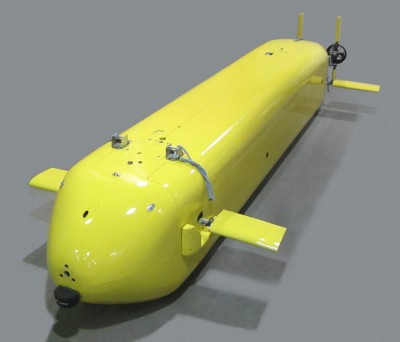GM Collaborating with US Navy to Create Fuel Cell-Powered UUVs
 General Motors announced today that it is collaborating with the Office of Naval Research and the US Naval Research Laboratory on developing the next generation of Navy unmanned undersea vehicles, or UUVs. GM says that it is working with the Navy to incorporate automotive hydrogen fuel cell systems into the watercrafts.
General Motors announced today that it is collaborating with the Office of Naval Research and the US Naval Research Laboratory on developing the next generation of Navy unmanned undersea vehicles, or UUVs. GM says that it is working with the Navy to incorporate automotive hydrogen fuel cell systems into the watercrafts.
Hydrogen fuel cells convert hydrogen into electricity, giving fuel cell-powered vehicles a greater range and endurance than battery-powered vehicles. The Naval Research Laboratory recently tested a prototype UUV equipped with a GM fuel cell powertrain in pools at the Naval Surface Warfare Center in Carderock, Maryland.
“Our in-water experiments with an integrated prototype show that fuel cells can be game changers for autonomous underwater systems,” said Frank Herr, the ONR’s department head for Ocean Battlespace Sensing. “Reliability, high energy, and cost effectiveness — all brought to us via GM’s partnering — are particularly important as Navy looks to use UUVs as force multipliers.”
Fuel cell vehicles operate on renewable hydrogen and emit only water vapor, with recharging taking only a few minutes. GM says that the company’s hydrogen fuel technology could eventually be used to augment ships and submarines on patrol.
“The collaboration with the Navy leveraged what we learned in amassing more than 3 million miles of real-world experience with our Project Driveway fuel cell program,” said Charlie Freese, the executive director of GM Global Fuel Cell Activities. “Our customers will benefit from additional lessons we learn about the performance of fuel cells in non-automotive applications that will be useful in GM’s drive to offer fuel cells across consumer markets.”

The News Wheel is a digital auto magazine providing readers with a fresh perspective on the latest car news. We’re located in the heart of America (Dayton, Ohio) and our goal is to deliver an entertaining and informative perspective on what’s trending in the automotive world. See more articles from The News Wheel.

